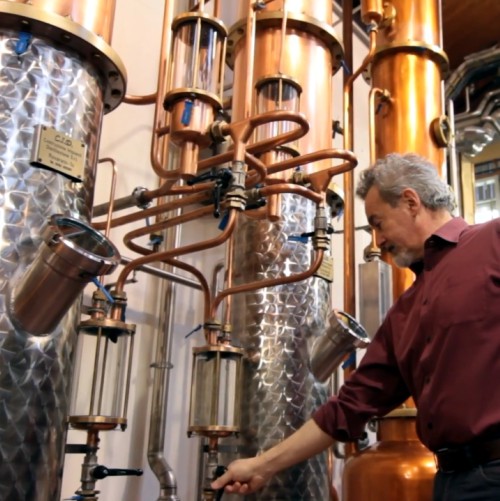9/13/2021 | Discovering Grappa
The alembics of Grappa
The alembics of Grappa
Discovering Grappa with Jacopo Poli.
I'm often asked: what's the different among alembic with direct fire, steam alembic and bain-marie alembic?
They are three different methods of heating the raw material.
Direct-fire still
They are three different methods of heating the raw material.
Direct-fire still
Let's begin with the easiest one: the so-called alembic with direct fire.
It's basically made of four parts: the boiler, or cucurbit, from the latin "cucurbitas" meaning pumpkin, because the boiler's shape looks like it, in which the raw material is placed.
The boiler is placed on a small oven, where the fire heats directly the boiler's base. Above the boiler there are: a helmet, a dome and a column capital, collecting the steams originated during the raw material's boiling.
The boiler is placed on a small oven, where the fire heats directly the boiler's base. Above the boiler there are: a helmet, a dome and a column capital, collecting the steams originated during the raw material's boiling.
The vapors are then directed inside a swan's neck connecting the dome to the serpentine, covered in a refrigerator and filled with cold water, which aim is to condensate the alcoholic steams.
This is the easiest method to distil, from which the stills that we still use is inspired: more specifically, the steam system and the bail-marie system used at the Poli Distillery.
Bain-Marie still
Bain-Marie still
The expression "bain-marie" derives from the person who invented this heating method. Her name was Miriam, Maria and she was a Jewish alchemist in the ancient times, who took inspiration from the sweet and protective heath of the mother's womb, welcoming and raising the child.
In fact, the bain-marie alembic is a compound of two pots, one inside the other. In the smallest pot we insert the raw material distilled.
The heat, in the form of steam or hot water, circulates in the serpentine between the biggest pot and the smallest one.
The heating wraps the raw material and brings the temperature to its boiling point in a progressive and delicate way. It is an optimal plant for the distillation of wine, grape, fruit and very aromatic grape marc, among which Moscato and Traminer; or the prosecco pomace, rather sensitive.
Steam still
Steam still
The steam still was conceived in the Nineteenth Century to distil the grape marc, the grape's skin, to obtain Grappa.
The alembic at the Poli Distillery was installed in 1898 and it is made of 12 copper pots.
They are in fact pots, inside which the raw material is placed and divided into 4 pierced-bottom baskets, to allow the steam blown into the bottom of the boiler to heat the pomace, as it flows from basket to basket.
They are in fact pots, inside which the raw material is placed and divided into 4 pierced-bottom baskets, to allow the steam blown into the bottom of the boiler to heat the pomace, as it flows from basket to basket.
At the fourth pot's exit, the steam will converge at the base of a little distillation column, whose aim is to concentrate its alcoholic part. At the column's summit the alcohol content obtained will reach 75% alc. vol.
The alcohol steam will then continue its journey inside a serpentine covered in cold water, where the vapor will be condensed in a drop of Grappa.
At this point the head, the first part, can be separated; the central one called heart, will be kept, as it is the best one and the last one, the tail, will be discarded.
At this point the head, the first part, can be separated; the central one called heart, will be kept, as it is the best one and the last one, the tail, will be discarded.
When it comes into contact with the grape's skin, the steam is rather powerful and can penetrate through it dragging along its aromatic part, enclosed in it.
The steam system is suitable to obtain Grappas of great personality and structure, thanks to the energy and strength that the steam has when it flows through the grape's skin.
Every alembic has specific feature that makes it eligible to distil a certain raw material.
A deep knowledge of every still is mandatory, as well as the knowledge of those properties featured in a specific raw material, but above all clear ideas are necessary to define the style of the spirit distilled.
A deep knowledge of every still is mandatory, as well as the knowledge of those properties featured in a specific raw material, but above all clear ideas are necessary to define the style of the spirit distilled.
Buona Grappa to everyone!


